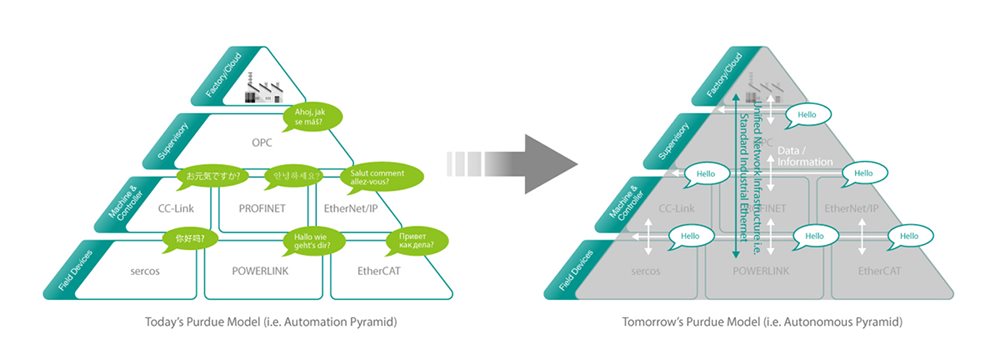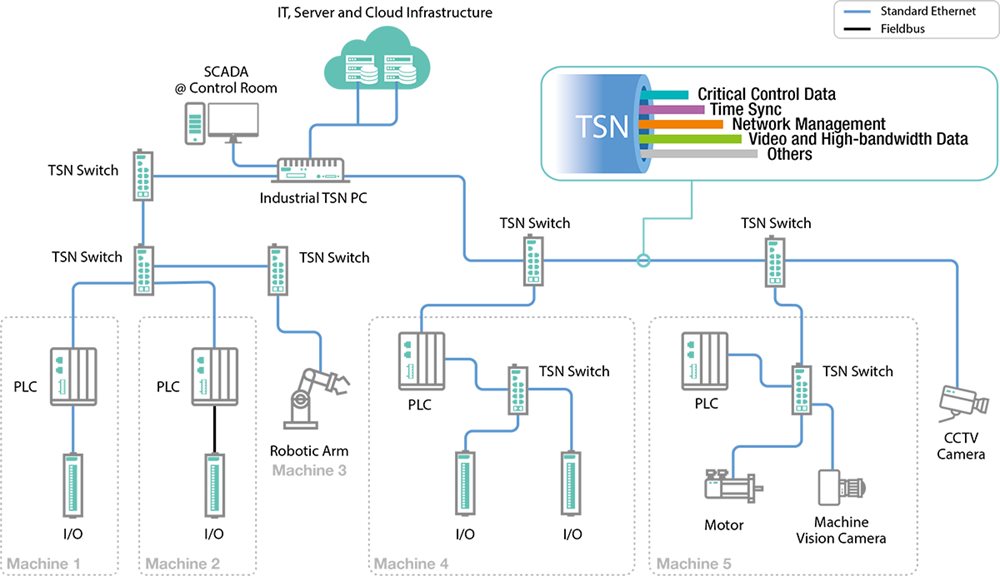Despite the tremendous impact of the COVID-19 pandemic on businesses, the Federal Reserve of the United States has forecasted a 4.2% growth in GDP for 2021*. The manufacturing sector is projected to have a crucial role in the recovery of the global economy. With optimism on the horizon, several influential figures in the manufacturing sector are gearing up to expand their production rapidly and more accurately to meet the rising demand. However, the success of this transformation will rely heavily on companies embracing innovative technologies to improve production efficiency and cut down maintenance expenses.
Time-sensitive networking (TSN) has been promoted as a technology that can aid Industry 4.0 and Industrial Internet of Things (IIoT) applications in achieving heightened production efficiency and reduced maintenance costs. Companies that have begun incorporating TSN technologies have showcased its practicality through numerous virtual demonstrations in 2020. But before we look ahead, there are key insights you should be aware of to guide you in making the right investments.
▎INQUIRY 1 ▎What are the advantages of adopting TSN?
A: TSN’s primary objectives are to seamlessly integrate accurate and time-sensitive data into industrial processes and provide a comprehensive view of operations for swift responses to real-time market demands. By leveraging TSN technologies, businesses can achieve these objectives and reap the following benefits:
- TSN facilitates high-speed networking, massive data transmission, precise motion control, and minimal latency.
- TSN can prioritize network traffic, ensuring real-time communication for crucial data to reach its destination promptly. This means that through a converged application on a unified network based on standard Ethernet, it becomes viable to have one network for multiple applications, diminishing concerns about critical data delivery delays. (Check out the demonstration video for more insights.)
- TSN aids in enhancing network security by scheduling accurate data transmission to avoid unauthorized data inflow.
 Diagram: One unified network for diversified applications
Diagram: One unified network for diversified applications
▎INQUIRY 2 ▎Is the concept of “one unified network” significant?
A: Absolutely, combining OT and IT networks into a unified network is crucial for enabling accurate and coordinated data that offers insights into production processes. However, achieving this convergence can be challenging, particularly in bridging gaps between the two sides and integrating isolated proprietary automation islands into OT environments. The benefits of one unified network include:
- Utilization of a single industry standard for communication.
- Reduced training efforts to grasp various vendor protocols.
- Decreased cabling and maintenance costs.
For a deeper understanding of the one unified network concept, refer to the article, Enabling Interoperability to Ensure the Success of TSN in Industry 4.0.
▎INQUIRY 3 ▎What are the potential applications for TSN?
Despite its origins in Audio Video Bridging (AVB), TSN is not limited to audio or video applications. The versatile features and benefits of TSN make it essential for various applications used across diverse industries such as semiconductor, automotive, machinery, food and beverage, chemical, and power generation. However, each TSN application has unique requirements, and there is currently a notable gap between existing TSN standards and application-specific TSN systems. Learn about the collaboration between Moxa and Xilinx in advancing time-sensitive networking technologies for Industry 4.0 applications in this press release.
▎INQUIRY 4 ▎Can my applications effectively utilize TSN technologies?
You can evaluate whether your organization should adopt TSN by reviewing the following statements.
 If you can check off more than three statements, TSN could be the ideal solution for your organization.
If you can check off more than three statements, TSN could be the ideal solution for your organization.
- You experience substantial costs when integrating standard or proprietary communication technologies.
- Debugging your existing network system is expensive due to an isolated networking structure.
- Managing your network system is challenging and necessitates tool development, consuming additional time and effort.
- You encounter interoperability issues between your current system and the IT system.
- You require increased network bandwidth for automated system development.
- You aspire to enhance network security.
▎INQUIRY 5 ▎Why should my organization consider implementing TSN if our current production processes and network setup suffice?
While your organization may be content with its current production output for now, in the long run, keeping up with competitors who embrace TSN technologies will become challenging. On one hand, you can continue expanding your production within the existing infrastructure; however, limitations will arise when disparate devices such as the conveyor belt communicating with the HMI via PROFINET, motion control using EtherCAT, and robotic arm control employing another protocol like Mitsubishi CC-Link IE, show compatibility issues. Though adding necessary add-on blocks may seem feasible, managing multiple devices from various vendors utilizing different industrial Ethernet technologies is complex. With isolated cells, integrating data becomes cumbersome, let alone optimizing processes for enhanced production efficiency. Over time, this approach will hinder the progress towards realizing Industry 4.0 and IIoT applications. Notably, TSN technology provides a plug-and-play solution when introducing additional applications like machine vision and motion cameras onto a unified network.

Diagram: Integrating more applications into TSN’s unified network
In essence, the convergence of IT and OT networks enables Industry 4.0 and IIoT applications. TSN serves as the link between these networks, enhancing network connectivity and lowering deployment costs. Although some may view TSN as an untested technology, it has evolved beyond just TSN switches, PLCs, servos, and IOs to form an ecosystem that supports the goals of IIoT and Industry 4.0 applications.
For detailed information on our TSN technologies, visit our microsite: www.moxa.com/TSN
*Source: Federal Open Market Committee Report
- Not Only for Automobiles: Discovering CANbus Technology in Various Industrial Settings - October 29, 2024
- Boost Your Network Performance: An Exciting Manual to PoE Switches! - September 10, 2024
- Understanding Gigabit Switches: Industrial vs Regular Gigabit - September 4, 2024


